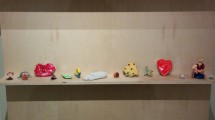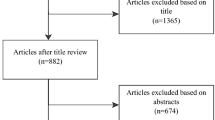Abstract
Adolescence is a developmental phase during which young people experience profound physical, emotional and social changes. The diversity and complexity of these changes has increased exponentially over the last 20 years. The arts provide important opportunities to enhance the resilience of adolescents with the benefits of engagement including improved interpersonal connectedness and greater short and long-term well-being. Cognisant of the complexity the authors recognise, a collective collation and analysis of the literature concerned with resilience, well-being and young people with a particular focus on the contribution of the arts to this area is valuable. This chapter ascertains how socioecological perspectives of the interrelations between well-being and resilience are being employed within existing structures and mechanisms in and through the arts to support young people to embrace specific enablers, or overcome inhibitors of their personal resilience and well-being.
Access this chapter
Tax calculation will be finalised at checkout
Purchases are for personal use only
Similar content being viewed by others
References
Aisenberg, E., & Mennen, F. (2000). Children exposed to community violence: Issues for assessment and treatment. Child and Adolescent Social Work Journal, 17, 341–360.
Barton, G. M. (2019). Developing the arts and literacy in schools. London: Routledge.
Barton, G. M., Baguley, M., Kerby, M., & MacDonald, A. (2019). Exploring how quality children’s literature can enhance compassion and empathy in the classroom context. In G. M. Barton & S. Garvis (Eds.), Compassion and empathy in educational contexts. London: Palgrave Macmillan.
Bertaux, D., & Thompson, P. (2017). Pathways to social class: A qualitative approach to social mobility. Abingdon, UK: Routledge.
Biesta, G. J. (2010). Why ‘what works’ still won’t work: From evidence-based education to value-based education. Studies in Philosophy and Education, 29(5), 491–503.
Bland, C. J. (1992). Characteristics of a productive research environment: Literature review. Academic Medicine: Journal of the Association of American Medical Colleges, 67(6), 385–397.
Bourdieu, P. (1986). The forms of capital. In J. Richardson (Ed.), Handbook of theory and research for the sociology of education (pp. 241–258). New York: Greenwood.
Breslau, N. (2002). Epidemiologic studies of trauma, post-traumatic stress disorder, and other psychiatric disorders. Canadian Journal of Psychiatry, 47(10), 923–929.
Bungay, H., & Vella-Burrows, T. (2013). The effects of participating in creative activities on the health and well-being of children and young people: A rapid review of the literature. Perspectives in Public Health, 133(1), 44–52.
Cavanaugh, B. (2016). Trauma-informed classrooms and schools. Beyond Behavior, 25(2), 41–46.
Chaplin, L. N., & John, D. R. (2007). Growing up in a material world: Age differences in materialism in children and adolescents. Journal of Consumer Research, 34(4), 480–493.
Chen, J., Lau, C., Tapanya, S., & Cameron, C. A. (2012). Identities as protective processes: Socio-ecological perspectives on youth resilience. Journal of Youth Studies, 15(6), 761–779.
Clarke, T. (2018). Do arts subjects matter for secondary school students’ wellbeing? Thinking Skills and Creativity, 29, 97–114.
Coholic, D. A. (2011). Exploring the feasibility and benefits of arts-based mindfulness-based practices with young people in need: Aiming to improve aspects of self-awareness and resilience. Child & Youth Care Forum, 40(4), 303–317.
Coleman, S., & Collins, P. (2006). Locating the field: Space, place and context in anthropology (ASA series). Oxford, UK: Berg Publishers.
Deleuze, G., & Guattari, F. (1987). Dialogues. London: Athlone Press.
Diamond, A., & Lee, K. (2011). Interventions shown to aid executive function development in 4 to 12 year olds. Science, 333, 959–964.
DiMaggio, P., & Mukhtar, T. (2004). Arts participation as cultural capital in the United States, 1982–2002: Signs of decline? Poetics, 32(2), 169–194.
Everly, J. G., Smith, K. J., & Lating, J. M. (2009). A rationale for cognitively-based resilience and psychological first aid (PFA) training: A structural modeling analysis. International Journal of Emergency Mental Health, 11(4), 249–262.
Ewing, R. (2011). The arts and Australian education: Realising potential. Melbourne, VIC: ACER.
Greene, R. R. (2007). Social work practice: A risk and resilience perspective. Monterey, CA: Brooks/Cole.
Heise, D. (2014). Steeling and resilience in art education. Art Education, 67(3), 26–30.
Homelessness Australia. (2016). Homelessness and young people. Australia: Homelessness Australia. Retrieved from https://www.homelessnessaustralia.org.au/sites/homelessnessaus/files/2017-07/Young%20People.pdf
Hunter, M. A., & MacDonald, A. (2017). Dark play: On an alternative politics of aspiration. In P. O. Connor & C. Gómez (Eds.), Playing with possibilities (pp. 16–33). Newcastle-upon-Tyne, UK: Cambridge Scholars Publishing.
Hyman, I. A., Zelikoff, W., & Clarke, J. (1988). Psychological and physical abuse in the schools: A paradigm for understanding post-traumatic stress disorder in children and youth. Journal of Traumatic Stress, 1(2), 243–267.
Ibeagha, P. N., Balogun, S. K., & Adejuwon, G. A. (2004). Resiliency of inner-city Yoruba University undergraduates in South Western Nigeria. Studies of Tribes and Tribals, 2(2), 125–129.
Irwin, E. C. (2006). Peter: A study of cumulative trauma from ‘robot’ to ‘regular guy’. In L. Carey (Ed.), Expressive and creative arts methods for trauma survivors (pp. 93–113). London, UK: Jessica Kingsley Publishers.
James, B. (1989). Treating traumatized children: New insights and creative interventions. New York, NY: The Free Press.
Karvonen, S., Rimpelä, A. H., & Rimpelä, M. K. (1999). Social mobility and health related behaviours in young people. Journal of Epidemiology & Community Health, 53(4), 211–217.
Kay, A. (2000). Art and community development: The role the arts have in regenerating communities. Community Development Journal, 35(4), 414–424.
Kay, L., & Arnold, A. (2014). Order from chaos: An arts-based approach to counteract trauma and violence. Art Education, 67(3), 31–36.
King, M. F., Renó, V. F., & Novo, E. M. (2014). The concept, dimensions and methods of assessment of human well-being within a socioecological context: A literature review. Social Indicators Research, 116(3), 681–698.
Klatt, M., Harpster, K., Browne, E., White, S., & Case-Smith, J. (2013). Feasibility and preliminary outcomes for move-into-learning: An arts-based mindfulness classroom intervention. The Journal of Positive Psychology, 8(3), 233–241.
Krovetz, M. L. (2007). Fostering resilience: Expecting all students to use their minds and hearts well. Thousand Oaks, CA: Corwin.
Livermore, J. (Ed.). (1998). More than words can say: A view of literacy through the arts. Canberra, ACT: Australian Centre for Arts Education, Faculty of Education, University of Canberra.
Lynch, P. (2007). Making meaning many ways: An exploratory look at integrating the arts with classroom curriculum. Art Education, 60(4), 33–38.
MacDonald, A., Hunter, M. A., Ewing, R., & Polley, J. (2018). Dancing around drawn edges: Reimagining deficit storylines as sites for relational arts teacher professional learning collaboration. Australian Art Education, 39(3), 455.
Macnaughton, J., White, M., & Stacy, R. (2005). Researching the benefits of arts in health. Health Education, 105(5), 332–339.
Massumi, B. (2002). Introduction. In B. Massumi (Ed.), A shock to thought: Expression after Deleuze and Guattari (pp. xiii–xxxix). London, UK: Routledge.
Napoli, M., Krech, P. R., & Holley, L. C. (2005). Mindfulness training for elementary school students: The attention academy. Journal of Applied School Psychology, 21, 99–125.
Ngo, B., Lewis, C., & Maloney Leaf, B. (2017). Fostering sociopolitical consciousness with minoritized youth: Insights from community-based arts programs. Review of Research in Education, 41(1), 358–380.
Nissley, N. (2010). Arts-based learning at work: Economic downturns, innovation upturns, and the eminent practicality of arts in business. Journal of Business Strategy, 31(4), 8–20.
Nunn, C. (2018). Dispersed belongings: A participatory arts-based study of experiences of resettled refugee young people in regional cities in Australia and the United Kingdom. A report for project partners. Manchester, UK: Manchester Centre for Youth Studies.
O’Sullivan, S. (2006). Art encounters Deleuze and Guattari: Thought beyond representation. London, UK: Palgrave Macmillan.
Oberle, E., Schonert-Reichl, K. A., Lawlor, M. S., & Thomson, K. C. (2011). Mindfulness and inhibitory control in early adolescence. The Journal of Early Adolescence, 20, 1–24.
Panter-Brick, C., & Leckman, J. F. (2013). Editorial commentary: Resilience in child development—Interconnected pathways to wellbeing. Journal of Child Psychology and Psychiatry, 54(4), 333–336.
Payne, H. (1993). Handbook of inquiry in the arts therapies: One river, many currents. London: Jessica Kingsley Publishers.
Perso, T., Nutton, G., Fraser, J., Silburn, S. R., & Tait, A. (2011). ‘The Arts’ in education: A review of arts in schools and arts-based teaching models that improve school engagement, academic, social and cultural learning. Darwin, NT: Menzies School of Health Research.
Pickering, C., & Byrne, J. (2014). The benefits of publishing systematic quantitative literature reviews for PhD candidates and other early-career researchers. Higher Education Research & Development, 33(3), 534–548.
Rankin, S. (2018). Cultural justice and the right to thrive (Platform papers, no. 57) (pp. 8–9). Sydney, NSW: Currency House.
Rhodes, A. M., & Schechter, R. (2014). Fostering resilience among youth in inner city community arts centers: The case of the artists collective. Education and Urban Society, 46(7), 826–848.
Rosenman, S., & Rodgers, B. (2004). Childhood adversity in an Australian population. Social Psychiatry and Psychiatric Epidemiology, 39(9), 695–702.
Schmitz, R., & Tyler, K. (2016). Growing up before their time: The early adultification experiences of homeless young people. Children and Youth Services Review, 64, 15–22.
Thompson, B., Molina, Y., Viswanath, K., Warnecke, R., & Prelip, M. L. (2016). Strategies to empower communities to reduce health disparities. Health Affairs, 35(8), 1424–1428.
Westphal, M., & Bonanno, G. A. (2007). Post-traumatic growth and resilience to trauma: Different sides of the same coin or different coins? Applied Psychology, 56(3), 417–427.
Yatham, S., Sivathasan, S., Yoon, R., da Silva, T. L., & Ravindran, A. V. (2018). Depression, anxiety, and post-traumatic stress disorder among youth in low and middle income countries: A review of prevalence and treatment interventions. Asian Journal of Psychiatry, 38, 78–91.
Author information
Authors and Affiliations
Corresponding author
Editor information
Editors and Affiliations
Rights and permissions
Copyright information
© 2020 The Author(s)
About this chapter
Cite this chapter
MacDonald, A., Baguley, M., Barton, G., Kerby, M. (2020). How Arts-Based Methods Are Used to Support the Resilience and Well-Being of Young People: A Review of the Literature. In: McKay, L., Barton, G., Garvis, S., Sappa, V. (eds) Arts-Based Research, Resilience and Well-being Across the Lifespan. Palgrave Macmillan, Cham. https://doi.org/10.1007/978-3-030-26053-8_3
Download citation
DOI: https://doi.org/10.1007/978-3-030-26053-8_3
Published:
Publisher Name: Palgrave Macmillan, Cham
Print ISBN: 978-3-030-26052-1
Online ISBN: 978-3-030-26053-8
eBook Packages: Behavioral Science and PsychologyBehavioral Science and Psychology (R0)




